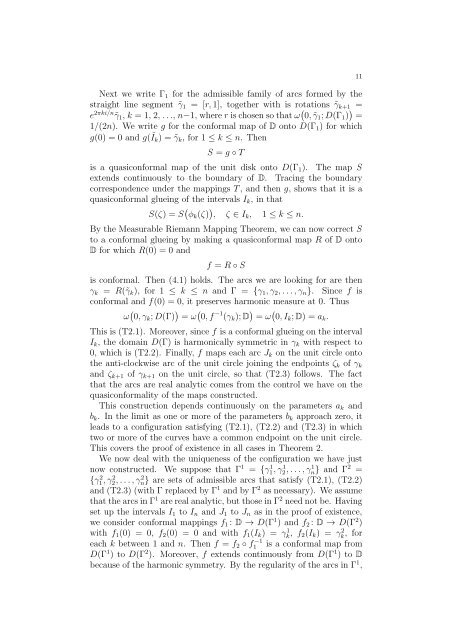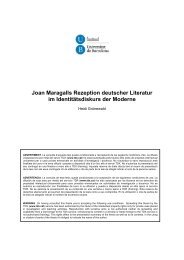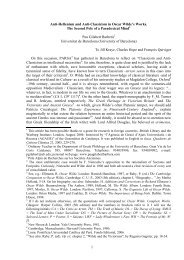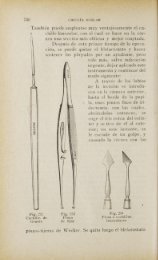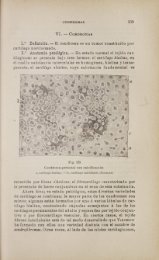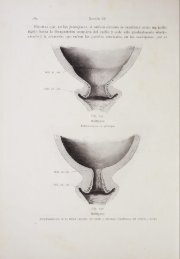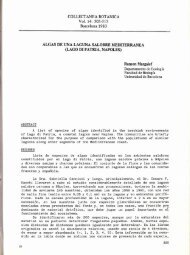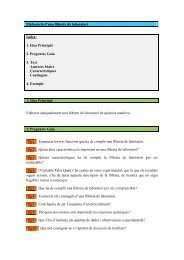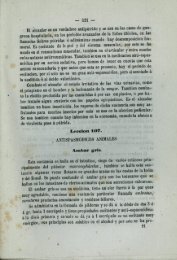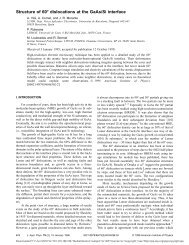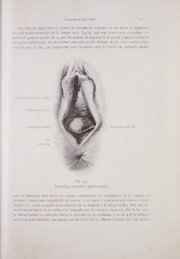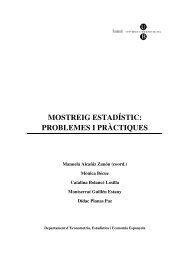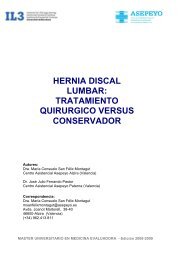The univalent Bloch-Landau constant, harmonic symmetry and ...
The univalent Bloch-Landau constant, harmonic symmetry and ...
The univalent Bloch-Landau constant, harmonic symmetry and ...
You also want an ePaper? Increase the reach of your titles
YUMPU automatically turns print PDFs into web optimized ePapers that Google loves.
Next we write Γ 1 for the admissible family of arcs formed by the<br />
straight line segment ˜γ 1 = [r,1], together with is rotations ˜γ k+1 =<br />
e 2πki/n˜γ 1 , k = 1,2, ..., n−1,whererischosensothatω ( 0,˜γ 1 ;D(Γ 1 ) ) =<br />
1/(2n). We write g for the conformal map of D onto D(Γ 1 ) for which<br />
g(0) = 0 <strong>and</strong> g(Ĩk) = ˜γ k , for 1 ≤ k ≤ n. <strong>The</strong>n<br />
S = g ◦T<br />
is a quasiconformal map of the unit disk onto D(Γ 1 ). <strong>The</strong> map S<br />
extends continuously to the boundary of D. Tracing the boundary<br />
correspondence under the mappings T, <strong>and</strong> then g, shows that it is a<br />
quasiconformal glueing of the intervals I k , in that<br />
S(ζ) = S ( φ k (ζ) ) , ζ ∈ I k , 1 ≤ k ≤ n.<br />
By the Measurable Riemann Mapping <strong>The</strong>orem, we can now correct S<br />
to a conformal glueing by making a quasiconformal map R of D onto<br />
D for which R(0) = 0 <strong>and</strong><br />
f = R◦S<br />
is conformal. <strong>The</strong>n (4.1) holds. <strong>The</strong> arcs we are looking for are then<br />
γ k = R(˜γ k ), for 1 ≤ k ≤ n <strong>and</strong> Γ = {γ 1 ,γ 2 ,...,γ n }. Since f is<br />
conformal <strong>and</strong> f(0) = 0, it preserves <strong>harmonic</strong> measure at 0. Thus<br />
ω ( 0,γ k ;D(Γ) ) = ω ( 0,f −1 (γ k );D ) = ω ( 0,I k ;D) = a k .<br />
This is (T2.1). Moreover, since f is a conformal glueing on the interval<br />
I k , the domain D(Γ) is <strong>harmonic</strong>ally symmetric in γ k with respect to<br />
0, which is (T2.2). Finally, f maps each arc J k on the unit circle onto<br />
the anti-clockwise arc of the unit circle joining the endpoints ζ k of γ k<br />
<strong>and</strong> ζ k+1 of γ k+1 on the unit circle, so that (T2.3) follows. <strong>The</strong> fact<br />
that the arcs are real analytic comes from the control we have on the<br />
quasiconformality of the maps constructed.<br />
This construction depends continuously on the parameters a k <strong>and</strong><br />
b k . In the limit as one or more of the parameters b k approach zero, it<br />
leads to a configuration satisfying (T2.1), (T2.2) <strong>and</strong> (T2.3) in which<br />
two or more of the curves have a common endpoint on the unit circle.<br />
This covers the proof of existence in all cases in <strong>The</strong>orem 2.<br />
We now deal with the uniqueness of the configuration we have just<br />
now constructed. We suppose that Γ 1 = {γ1,γ 1 2,...,γ 1 n} 1 <strong>and</strong> Γ 2 =<br />
{γ1,γ 2 2,...,γ 2 n} 2 are sets of admissible arcs that satisfy (T2.1), (T2.2)<br />
<strong>and</strong> (T2.3) (with Γ replaced by Γ 1 <strong>and</strong> by Γ 2 as necessary). We assume<br />
thatthearcsinΓ 1 arerealanalytic, butthoseinΓ 2 neednotbe. Having<br />
set up the intervals I 1 to I n <strong>and</strong> J 1 to J n as in the proof of existence,<br />
we consider conformal mappings f 1 : D → D(Γ 1 ) <strong>and</strong> f 2 : D → D(Γ 2 )<br />
with f 1 (0) = 0, f 2 (0) = 0 <strong>and</strong> with f 1 (I k ) = γk 1, f 2(I k ) = γk 2, for<br />
each k between 1 <strong>and</strong> n. <strong>The</strong>n f = f 2 ◦f1 −1 is a conformal map from<br />
D(Γ 1 ) to D(Γ 2 ). Moreover, f extends continuously from D(Γ 1 ) to D<br />
because of the <strong>harmonic</strong> <strong>symmetry</strong>. By the regularity of the arcs in Γ 1 ,<br />
11


